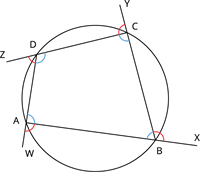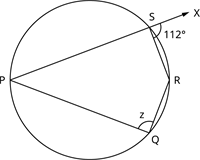
PUMPA - SMART LEARNING
எங்கள் ஆசிரியர்களுடன் 1-ஆன்-1 ஆலோசனை நேரத்தைப் பெறுங்கள். டாப்பர் ஆவதற்கு நாங்கள் பயிற்சி அளிப்போம்
Book Free DemoIllustration:
Consider a cyclic quadrilateral ABCD and extend the side AB to E.

Here, the angles \angle ABC and \angle CBE are a linear pair.
It is known that the sum of the linear angle is 180^{\circ}.
So, \angle ABC + \angle CBE = 180^{\circ} …… \text{equation }(1)
Also, in a cyclic quadrilateral, the sum of the interior opposite angles is 180^{\circ}.
So, \angle ABC + \angle ADC = 180^{\circ} …… \text{equation }(2)
From equation (1) and (2), we have:
\angle ABC + \angle CBE = \angle ABC + \angle ADC
Hence, \angle CBE = \angle ADC.
Similarly, all the other angles can be proved.
Based on this result, the following theorem is obtained.
Theorem: If one side of a cyclic quadrilateral is produced, then the exterior angle is equal to the interior opposite angle.
Explanation:

The theorem states that if any side of a cyclic quadrilateral is produced (extended), then the exterior angle formed on that side is the same as the interior opposite angle.
Here, in the figure, the side AB is produced to X, the side BC is produced to Y, the side CD is produced to Z and the side DA is produced to W. Then:
\angle CBX = \angle CDA
\angle DCY = \angle DAB
\angle ADZ = \angle ABC
\angle BAW = \angle BCD
Example:
Find the unknown angle z in the figure.

Solution:
By the exterior angle of a cyclic quadrilateral theorem, \text{Exterior angle} = \text{Interior opposite angle}.
Hence, \angle RSX = \angle PQR
Therefore, z = 112^{\circ}.